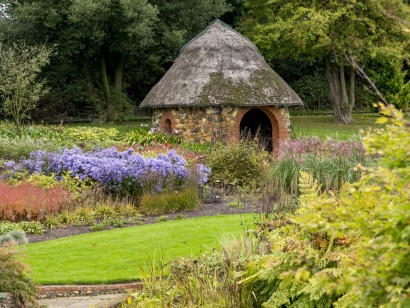England Birds & Gardens: Southeast 2022 Trip report
Saturday, 23rd April – Wednesday 4th May 2022
Leaders: Mike Hoit & Sally Jacobs
Day 1 – Arrival
It was something of a relief to all meet up safely at our hotel close to London’s Heathrow Airport for a first get together. After over two years of limited travel and various covid-related hurdles to clear, it was good to be starting a tour! After getting to know one another and a meal that included the first of many sticky toffee puddings, we retired early to recover from our travels and prepare for the first day proper of our journey.
Day 2 – Kew Gardens
Set in the leafy west side of London, the Royal Botanic Gardens at Kew, are renowned for beautiful formal and semi-natural features, and for the conservation work carried out there. On a pleasant spring day, our explorations took in a fair selection of the sights. First we marvelled at the rhododendron dell, giant snowdrops and leafless, flowering Judas Trees, before arriving at the avenue of cherry trees with literally thousands of tulips beneath. The Mediterranean Gardens, Temperate and Tropical Houses provided more – very varied – interest, with the glasshouses looking wonderful among the verdant settings.
Some of our first birds were as colourful and as exotic as the surroundings. We watched plenty of noisy Rose-ringed Parakeets which have found this part of the world much to their liking, while on waterbodies we found Mandarins and Red-crested Pochard – two gaudy ducks which have established feral populations. A variety of widespread woodland species included beautiful Eurasian Jays, singing Blackcaps, both Blue and Great Tits, and a nesting pair of Mistle Thrushes harassing a Carrion Crow. Ponds set amongst the woodlands gave us close views of common waterbirds such as Tufted Duck, Moorhen Little Grebe, and we were entertained by a family of Eurasian Coots attending to their tiny chicks. After a lunch in one of the busy cafes, it was time to walk back through avenues to oaks to the vehicles, brave the London traffic and head for Essex. Compared to some trips, this was surprisingly hassle free and we arrived at our very comfortable hotel with plenty of time to relax before traditional Sunday roast in a nearby pub.
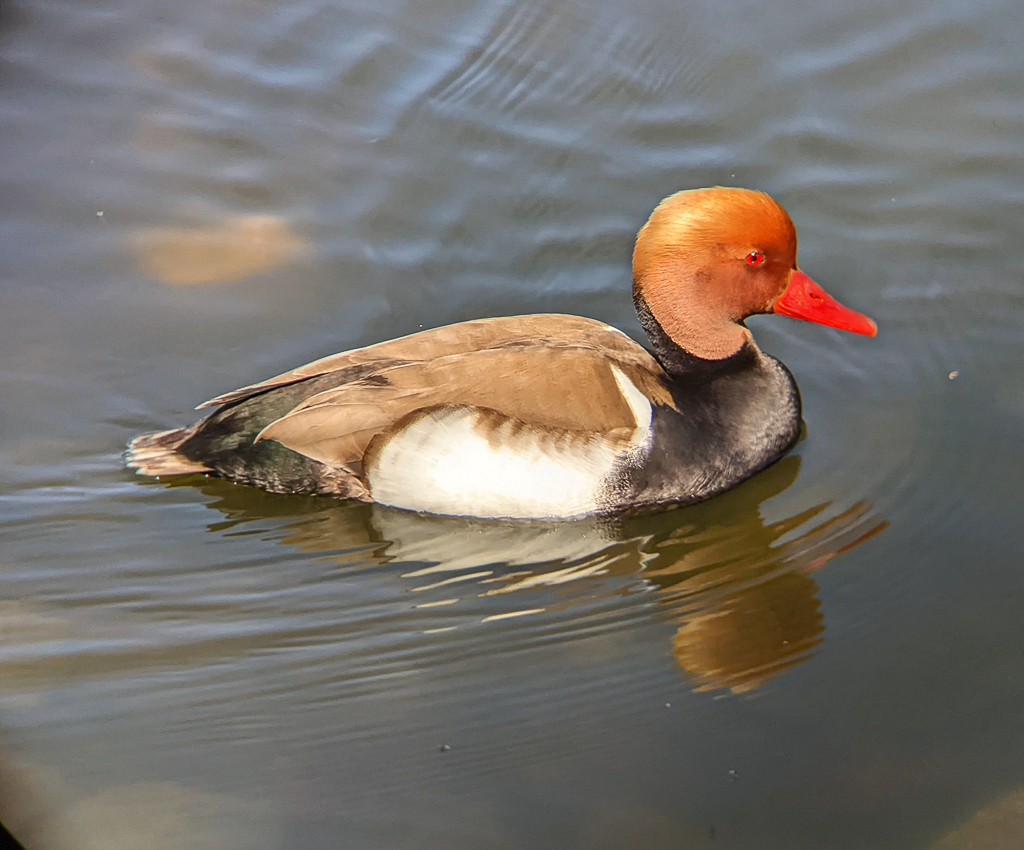
Red-creasted Pochard © Michael Hoit
Day 3 – Abberton Reservoir and Hyde Hall
Today began with the novelty of a self-catered light breakfast in the lodge, before we travelled east to Abberton Reservoir. This huge man-made lake can provide water for most of Essex and parts of London, but also provides a home for abundant wildlife. Only a few of the thousands of ducks present in winter had lingered into spring, but from the dam we watched Gadwall, plenty of stunning Great Crested Grebes in breeding finery, and close Common Tern. A – literally – big surprise was a White Stork circling just overhead: only a few of these huge birds wander to the UK from mainland Europe each spring. A family of Egyptian Geese fed nearby, and a couple of Yellow Wagtails were around, with a backdrop of many singing Skylarks. The nearby woodland is a good spot for Nightingales, and typically were easier to see then hear! However, after some sneaky birds playing hide-and-seek, one decided to sit in full view giving his beautiful song. Lots of Common Whitethroats were singing, although we had better views of a Lesser Whitethroat, and we continued to get nice looks at common species like Chaffinch, Chiffchaff and Long-tailed Tit. Wild flora was abundant, with oak-apple galls formed by parasitic wasps on the oaks, some fine Field Maples, and banks of spiky Teasels.

Nightingale © Michael Hoit
Everyone was ready for a good lunch, so it was time to head to the café at Hyde Hall. Suitably re-fuelled, we explored Royal Horticultural Society’s world-class demonstration gardens, made easier by getting ride to the hilltop with its views across rural Essex. There aren’t many places one can walk from a large vegetable plots via extensive rose gardens to a dell of tree ferns! The beds of hellebores and wild flowers such as forget-me-nots and cowslips were also looking great, while the Mediterranean gardens on the south-facing slope were fascinating. Like so many gardens, Robins were particularly confiding here. In the late afternoon, we returned to the hotel for an exceptional evening meal.
Day 4 – Marks Hall and Beth Chatto Gardens
First on the agenda today was the rolling, wooded landscape of Mark’s Hall, on a warm, sunny morning. First we took a stroll uphill, following the stream to the walled gardens (complete with displaying Peacocks), enjoying the formal flower beds and looking out over lakes surrounded by mistletoe-clad trees. A calling Cuckoo passed overhead a couple of times, and we had excellent views of a low-flying Red Kite. A change of scenery was next, with the ‘Gondwanaland’ section of the arboretum, featuring monkey-puzzles, eucalypts and Nothofagus species which have been largely unchanged for tens of millions of years. Another star tree here was the fascinating Wollemi Pine, known only from fossils until 1984 before being discovered in a tiny area of Australia, where only a few hundred trees occur in the wild.
Then it was back down through the old natural woodlands which contain amazing ancient oak trees including the 800 year old Honywood Oak, before heading off east to the Beth Chatto Gardens.
Beth Chatto created this impressive place from disused farmland, a huge undertaking that thanks to sound ecological thinking alongside classic horticultural techniques have resulted in an oasis in the suburbs of the town of Colchester
As with all of these gardens, there were also birds to see, with Robins, Wrens, Long-tailed Tit; most interesting was a Song Thrush using pebbles as an ‘anvil’ to smash open snail shells and get at the gastropod within! By late afternoon it was time to leave Essex and travel to the East Anglian county of Suffolk, staying in the small village of Westleton for three nights.
Day 5 – Westleton Heath and Minsmere
In the not too distant past, the a belt of open, heather-and-gorse-covered habitat known as The Sandlings extended in a swath down the Suffolk coast. Now, sadly, this has been reduced to a few remnants of lowland heath, one of the best of which was very close to the hotel. So we made a pre-breakfast excursion in search of the special birds of area. The number of Nightingales along the scrubby margins was impressive, and while only a couple were seen briefly, the loud melodious song was a constant backdrop. We had a very good sighting of the weird, dry-country shorebird known variously as Eurasian Thick-knee, Stone-curlew or – in this area – Wailing Heath Chicken, but Dartford Warblers proved somewhat elusive. A small group of Red Deer were also spotted.6+
Following a (very) filling breakfast back at the hotel, it was time to make our first explorations of Minsmere, just a short drive away. This is the RSPBs flagship reserve, famed for its diversity of habitats and species, made all the more remarkable considering that it was arable farmland as recently as 1940. After being deliberately flooded as a defence against feared invasion during the Second World War, it was colonised by Pied Avocets – the first time the species had nested in the UK for 100 years – and protected as a reserve. These elegant black and white waders were one of the first species we saw from a hide overlooking the lagoons, and we had good views along with many other waterbirds, such as nesting Northern Lapwings and Barnacle Geese. Our walk followed the North Wall through sandy fields, scrub and reedbeds to the beach, then along the dunes to more strategic scanning points over shallow pools. Reed, Sedge and Cetti’s Warblers were singing in good numbers from the vegetation and we got some good looks at the former, while Eurasian Marsh Harriers floated over the reeds. Among the masses of nesting gulls we saw a few Mediterranean Gulls and both Common and Sandwich Terns, Common Shelducks gave good views, and shorebirds included Bar-tailed and Black-tailed Godwits, Common Sandpiper, and Dunlin. Nearer the visitor centre, we enjoyed the nesting Bank Swallows, and a Nuthatch on the feeders, along with our customary re-fuel in the café! After a relaxing afternoon, the day was rounded off with a dinner in a pub in the historic settlement of Dunwich.
Day 6 – Minsmere and Dunwich
Today we made a reserve visit to Minsmere, targeting a quite different sections of the reserve dominated by wet woodland and extensive reedbeds, hoping for a couple of very special species. Spending a good chunk of the morning in a spacious hide overlooking Island Mere, the highlight was undoubtedly a beautiful male Bearded Reedling foraging right below the window for several minutes – probably the best views I’ve ever had of the species, which id often tricky to see. We also had some good looks in the scope at Reed Bunting and Sedge Warbler, some close Eurasian Marsh Harriers, and – for some – a Water Rail. However, our other target, the very elusive Great Bittern, was only heard, giving its strange, low, far-carrying ‘booming’. A couple of us took the longer walk back to the visitor centre, and were lucky enough to see one of these reed-loving herons, albeit slightly distantly, plus another brief Water Rail. A return visit to one of the hides produced a similar set of species to yesterday.
We had lunch at a café by the long, shingle beach at Dunwich. Walking around the tiny village now, it is hard to envision that a thousand years ago it was a bustling port town equivalent in importance to London! The ruins of the medieval Franciscan friary on the low cliffs to the beach are the most obvious hint that this was a significant settlement before a succession of storm surges dramatically altered the coastline, ultimately reducing the population from 3,000 to less than 200 today.
The afternoon was spent at leisure around the hotel before with ended our stay in the area with another excellent meal.
Day 7 – Westleton Heath, Bressingham Gardens and Wyken Hall
As Dartford Warbler has still evaded most of the group, we made an early return to Westleton Heath this morning. After quite a lot of effort, we pinned down a smart male giving his scratchy warble. Other nice sightings included brightly-coloured Yellowhammers, Wood Larks giving their fluty song low overhead, and dapper Stonechats.
After breakfast (and warming up!) it was time to travel on to Bressingham Gardens, where we took in the displays of trees, shrubs and flower beds. At this time of year, the range of flowers in bloom is limited, but the gardens still look fantastic, as colours are created by shades of green through creative planting. The Foggy Bottom gardens is another example of perfectly laid-out lawns and larger shrubs, where we watched Goldcrests giving their high-pitched song at eye-level.
After lunch, we visited Wyken Hall. Here we explored the small ‘rooms’ of the gardens around the hall itself with ‘five-ring’ displays, and further afield to the wildflower meadows full of Snakes-head Fritillaries and trees surrounded by mature trees. The maze provided some entertainment, as did a Goldfinch sitting tight on its nest, and some fledgling Blackbirds. After a long day, we were glad the drive to Thetford, in the heart of Breckland, was a short one, where we checked in and convened for dinner at the hotel.
Day 8 – Thetford Forest and Fairhaven Water Gardens
We took an early light breakfast this morning, before a fine, sunny morning in Thetford Forest. This is a large, mostly pine, artificial forest was created after World War One had depleted the UK timber stocks; however, this act destroyed the previous sandy heaths and pine belts – the Brecks – but there are still some good birding areas. One of these areas is the mosaic of habitats along the River Little Ouse at Santon Downham, where we found a number of woodland species. Tree Pipits gave a close views – another of the brown, streaky birds redeemed by a lovely song! – Garden and Cetti’s Warblers sang along the railway line, and Stock Doves and Wrens showed along the river. We eventually got brilliant views of a territorial pair of Green Woodpeckers too, much to the delight of some.
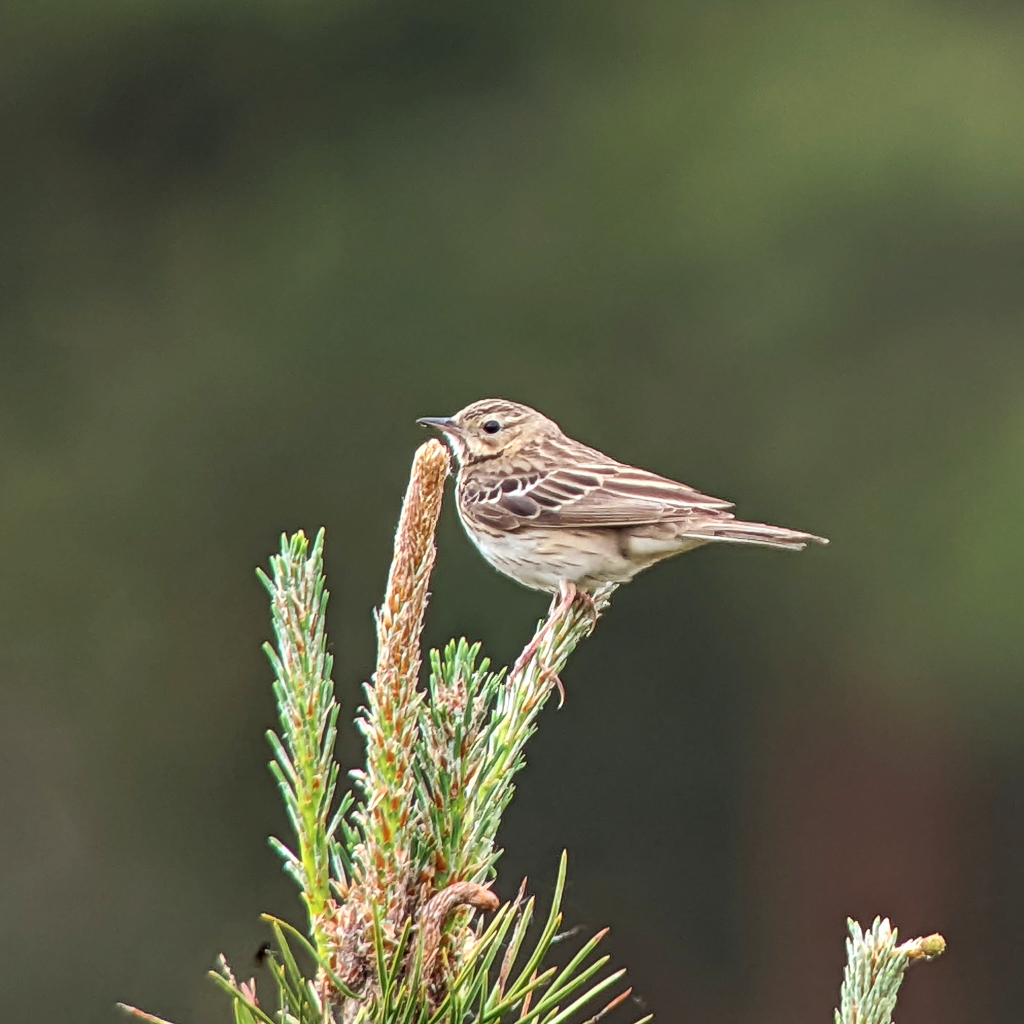
Tree Pipit © Michael Hoit
Next up was Lynford Arboretum, where the Forestry Commission showcase a variety of well-labelled shrubs and trees. It was very busy, but we found some quiet spots among the tall trees and were rewarded with good looks at Firecrests and Eurasian Siskins – two very lovely looking birds.
After lunch, our journey north into Norfolk took in Fairhaven Water Gardens, with its wildlife-rich gardens and wet alder ‘carr’ woodland, a classic habitat of the Norfolk Broads. American Skunk-cabbages and natives such as primroses, irises and cuckooflower were in bloom, in this beautiful setting. Of course there were plenty of common woodland birds around, including chickadee-like Marsh Tits, an entertainingly tame Pied Wagtail, and Common Terns over the waterways. We then made the drive to our hotel overlooking the North Norfolk coast.
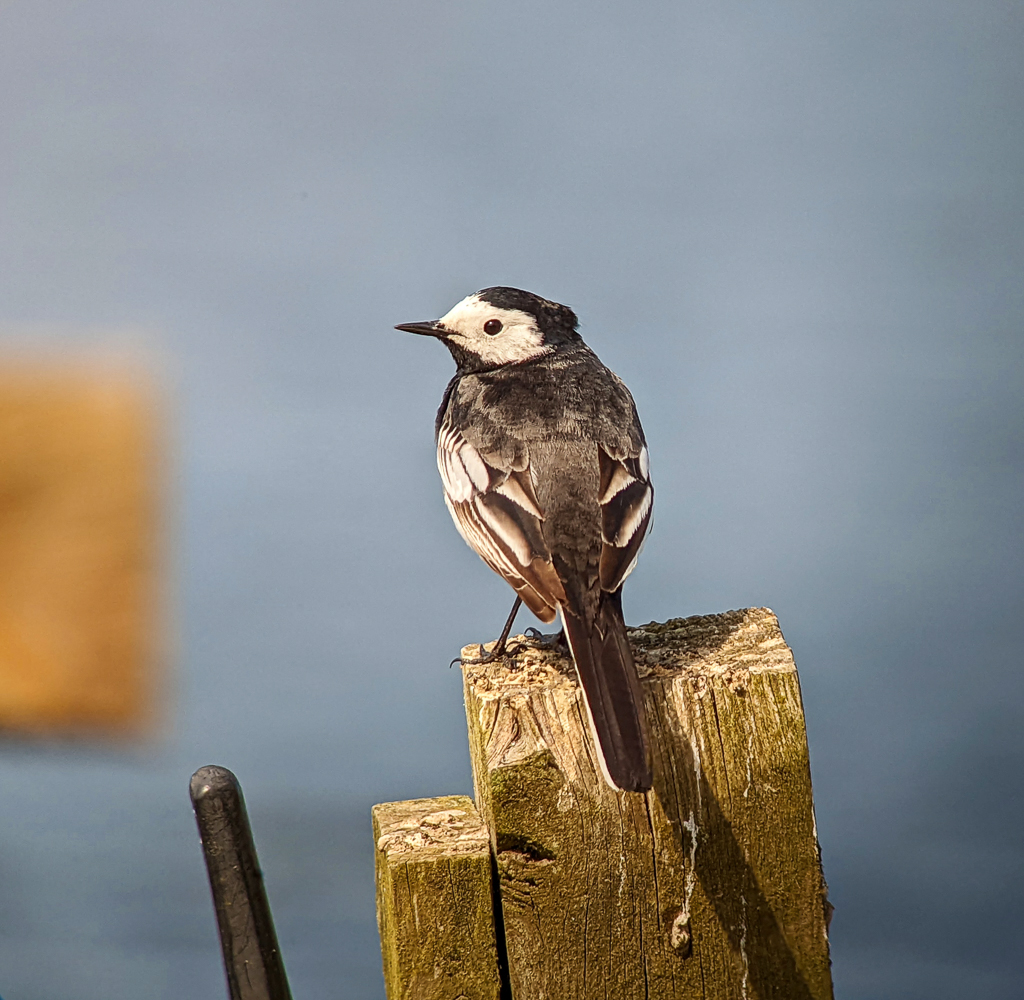
Pied Wagtail © Michael Hoit
Day 9 – Hickling Broad and East Ruston Old Vicarage
A couple of us took an early morning walk along the cliffs close to the hotel prior to the day’s main excursion. As well as a good appetite for breakfast, this gave us singing Meadow Pipits and Skylarks, Yellow Wagtails, and two Ring Ouzels – a scarce thrush on spring migration here.
By mid-morning, we were at the Norfolk Wildlife Trust’s Hickling Broad Reserve. The Norfolk Broads are vast expanse of open water and reedswamps, formed by a combination of low-lying land and ancient peat digging, fringed by woodland. Nowadays, it provides am important wildlife habitat, alongside a lot of human recreation, and at Hickling a new man-made lagoon provides great birding. Plenty of Marsh Harriers and warblers were around, and very smart male Garganey was seen alongside Red Knot, Wood Sandpiper, and Little Egret, plus a very late (normally only present in winter) Greater White-fronted Goose. Unfortunately the locally-breeding Common Cranes only performed a distant flypast. Some of us continued a longer walk around the reserve, enjoying the extensive views, while others (finally!) got good views of Cetti’s Warbler.

Birding at Hickling Broad © Sally Jacobs
It was only a short journey from Hickling to East Ruston Old Vicarage Gardens, where we had lunch before exploring the gardens. This is a very cleverly designed location, a stone’s throw from the North Sea, is divided into discrete sections divided by tall hedges which create windbreaks and tunnels form ‘borrowed landscapes’ of the surrounding countryside. Bright displays of tulips and camassias brighten up the courtyards and formal gardens, which seem to go on forever – remarkable for a garden created privately, and relatively recently. Upon leaving, some of us chanced upon a roadside Merlin, which gave incredible views as it consumed a small songbird.

Camassias, East Ruston © Michael Hoit
Day 10 – Titchwell and Holkham Hall
After a later-than-planned departure after a vital member of the hotel staff failed to show up on time, we were off across Norfolk to another RSPB reserve – Titchwell Marsh. This is one of my favourites, as the views of birds are often so good. From the path we saw a few new species such as Common Pochard, and old favourites like Pied Avocet and Eurasian (Green-winged) Teal. After arriving at the well-positioned hide, close views were had of displaying Little Ringed Plovers, displaying Redshanks, and bathing Linnets, plus a flock of Brant (known here as Dark-bellied Brent Goose). Continuing towards the coastal pools, we were rewarded with a weird and wonderful Spoonbill, sieving the water with its spatulate bill before flying off towards a nesting colony.
The next stop was made another favoured location of mine: Burnham Deepdale café, with fine homemade quiches, pies and sandwiches! Due to the delayed start to the day, and as we had done so well with marshland birds (and had done enough walking through reedbeds and sitting in hides!), I made the decision to forgo a visit to Cley in favour of a more varied afternoon. So we took a scenic journey along the lovely North Norfolk Coast, stopping at Blakeney Harbour, Cley Beach and a nearby windmill, and the traditional seaside resort of Sheringham, where we were duty-bound to get ice creams. The day finished within another classic of this part of the world, with a visit to a restaurant serving delicious fish and chips in the town of Cromer.
Day 11- Welney WWT and Cambridge University Botanic Gardens
With a long journey to London ahead of us and various admin to be dealt with prior to international travel, we opted for a change from the planned itinerary for the final day. So after departing the hotel, we travelled to the opposite corner of Norfolk, an area known as the fens. Formerly an enormous semi-tidal swamp, this is now highly fertile farmland, which has the issue of being below sea level! Huge levees protect these fields, and the area in-between – the washes – in turn form a great wildlife area of wet grassland. While this spot is at its best in winter when huge numbers of waterbirds arrive, the reserve managed by the Wildfowl and Wetlands Trust always holds something of interest. Today we found several Great Egrets, a male Ruff (a shorebird with an amazing breeding display and long head plumes to match), Bar-tailed and Black-tailed Godwits gave a last chance to cause confusion, and a few Whooper Swans lingering from winter were present. Around the visitor centre we found breeding House Martins, Tree Sparrows, and a pair of Chinese Water Deer.
The final destination of the tour was the Cambridge University Botanic Gardens, a beautiful spot with far too much to see in our all-too-short visit. Everyone will have their favourite spots, but the lake and surrounding rock gardens were particularly attractive, while the nearby area with native plants was buzzing with insect life. The stunning glasshouses contained a wealth of plants from around the globe, with jade vines, and the flora of South Africa’s fynbos standing out.

Cambridge Botanic Garden © Michael Hoit
Fortunately we missed the worst of rush hour, and got to the airport hotel in reasonable time. Rather than sample the ‘delights’ of dinner at a chain hotel, the final dinner together was had at an old-style pub in a village not far from the hotel. Over some more fine traditional food, we celebrated a successful tour and said our goodbyes before parting ways – for some, very early! – the next day. Thanks to all, who made this trip a real pleasure.
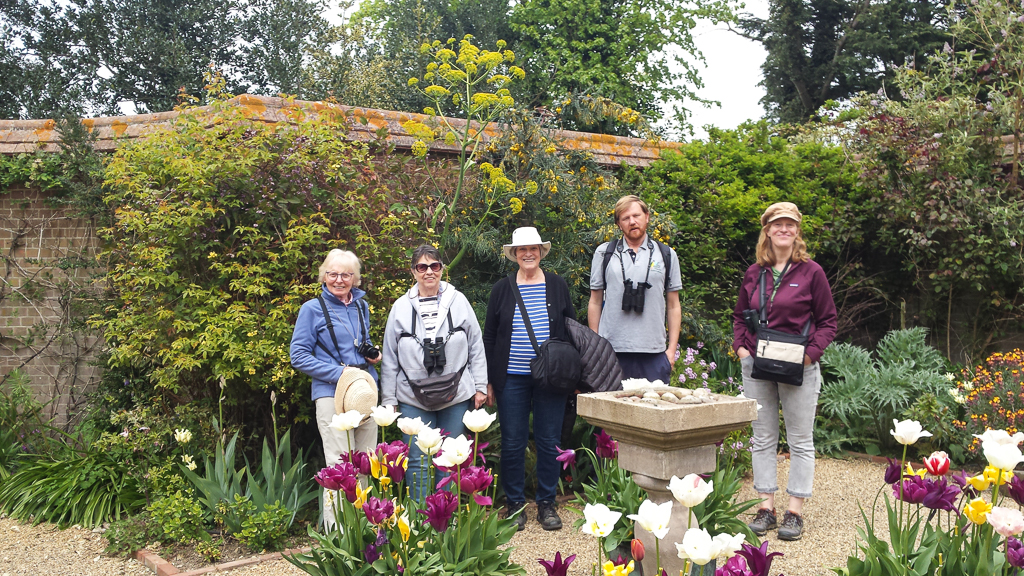
Vicarage, East Ruston © Sally Jacobs

